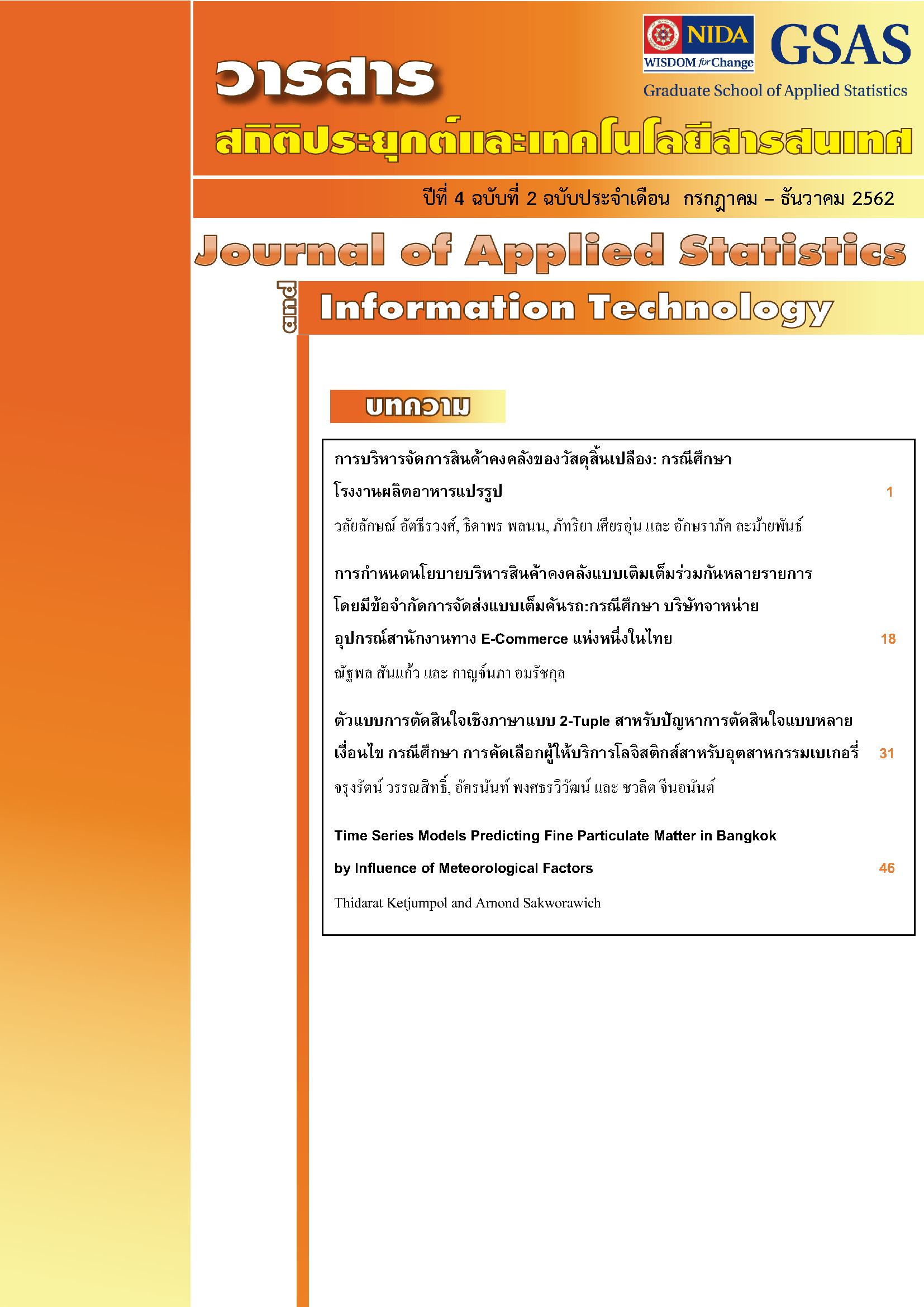การบริหารจัดการสินค้าคงคลังของวัสดุสิ้นเปลือง: กรณีศึกษา โรงงานผลิตอาหารแปรรูป
Keywords:
การจำลองสถานการณ์แบบมอนติคาร์โล, การวิเคราะห์แบบ ABC, ปริมาณการสั่งซื้อที่ประหยัด, ระดับสินค้าคงคลัง วัสดุสิ้นเปลืองAbstract
This research aims to find the optimal order policies of supplies used in a food production plant. Currently, this case company has determined policy for purchasing those required supplies according to their demands from the past which did not have any policy applied as yet. According to the past data, it was revealed that some items were shortage, whereas the others had too much amounts than the requirements. As a result, the total inventory cost was increased. The research was proposed the optimal order policy to determine a suitable inventory level and reorder point for supplies item for the case company. ABC classification technique was applied for grouping supplies items and then only one item i.e. heat seal tape was employed as a representative for analysis using Economic Order Quantity and Monte Carlo Simulation techniques. After that, the total inventory costs from both techniques were compared in order to select the suitable one.
The findings were revealed that the Monte Carlo Simulation techniques gave a lower cost. While considering a coefficient of variation (VC) of the usage demand of heat seal tape within a past year, it was 1.27. It is accordance with Peterson-Silver rule which stated that if the usage demand of each item is not stable or VC is higher than 0.20, EOQ technique is not appropriate for determining a suitable inventory level and reorder point.
References
ธนัญญา วสุศรี. (2552). การจัดการสินค้าคลังและการกระจายสินค้า.กรุงเทพ ฯ: หจก.สุเนตรฟิล์ม
ธนัญญา วสุศรี และ วลัยลักษณ์ อัตธีรวงศ์. (2553). การบริหารสินค้าคงคลัง. หลักสูตรการพัฒนาผู้บริหารระดับกลาง โครงการพัฒนาหลักสูตรและการฝึกอบรมโลจิสติกส์และซัพพลายเชน. สำนักงานคณะกรรมการการอุดมศึกษา (สกอ.) และเครือข่ายนักวิจัยด้านการจัดการโลจิสติกส์และโซ่อุปทานในประเทศไทย.
พิภพ ลลิตาภรณ์. (2552). การบริหารพัสดุคงคลัง. กรุงเทพฯ: สมาคมส่งเสริมเทคโนโลยี (ไทย-ญี่ปุ่น).
วลัยลักษณ์ อัตธีรวงศ์. (2561). การวางแผนการผลิต. กรุงเทพ ฯ: คณะวิทยาศาสตร์ สถาบันเทคโนโลยีพระจอมเกล้าเจ้าคุณทหารลาดกระบัง.
วัลลภ ภูผา. (2557).การประยุกต์ใช้เทคนิคการจําลองสถานการณ์แบบมอนติคาร์โล เพื่อหาปริมาณการสั่งซื้อที่เหมาะสม กรณีศึกษา การจัดซื้อวัตถุดิบในโรงงานผลิตอาหารแปรรูป.วิศวกรรมสาร มหาวิทยาลัยเกษตรศาสตร์, 88(27), 41-56.
Hong J.D. and Hayya J.C. (1990). On an (s, Q) Production Policy for an Integrated Inventory Model for a Single Product with Linearly Increasing Demand. The Journal of the Operational Research Society, 41(10), 931-942.
Khouja M. (1995). The economic production lot size model under volume flexibility. Computers and Operations Research, 22(5), 515–523.
Lordahl, A. E. and Bookbinder J. H. (1994). Order-statistic calculation, costs and service in an (s, Q) inventory system. Naval Research Logistics, 81–97.
Downloads
Published
How to Cite
Issue
Section
License
เนื้อหาและข้อมูลที่ปรากฏในบทความที่ตีพิมพ์ในวารสารสถิติประยุกต์และเทคโนโลยีสารสนเทศถือเป็นความคิดเห็นส่วนบุคคลของผู้เขียนแต่ละท่าน ความผิดพลาดของข้อความและผลที่อาจเกิดจากนำข้อความเหล่านั้นไปใช้ผู้เขียนบทความจะเป็นผู้รับผิดชอบแต่เพียงผู้เดียว บทความ ข้อมูล เนื้อหา รูปภาพ ฯลฯ ที่ได้รับการตีพิมพ์ในวารสารถือเป็นลิขสิทธิ์ของวารสาร หากบุคคลหรือหน่วยงานใดต้องการนำทั้งหมดหรือส่วนหนึ่งส่วนใดไปเผยแพร่ต่อหรือเพื่อกระทำการใดๆ จะต้องได้รับอนุญาตเป็นลายลักอักษรณ์จากวารสาร ก่อนเท่านั้น



